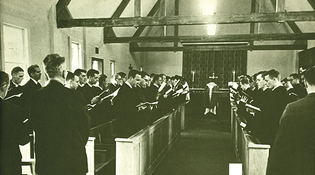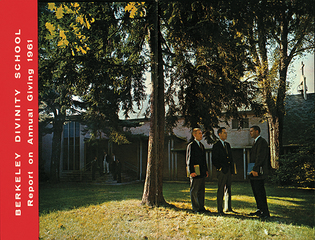 loading
loading
Old YaleA bygone campusUndergrads now live where the Berkeley Divinity School stood. Mark Alden Branch ’86 is executive editor of the Yale Alumni Magazine. Judith Ann Schiff will resume her Old Yale column in the next issue.  Yale Divinity School LibraryPublications from the 1960s show the Berkeley Divinity School’s chapel (above), which later became part of Donaldson Commons, and its courtyard (below). The building behind the students is Urban Hall, which later was Yale’s social science library. View full image Yale Divinity School LibraryView full imageWhen you come back to your old school, you have to be prepared for a few changes. You might find that your favorite haunt has been renovated or a landmark building razed. But for those who graduated from the Berkeley Divinity School before 1971, when it merged with Yale, the change is much more radical: between 2009 and 2012, the entire former campus of Berkeley was demolished. For 117 years, Berkeley Divinity School was a freestanding Episcopal seminary that prepared men for priesthood. It was established in Middletown, Connecticut, in 1854, but moved to New Haven in 1928 so as to draw on the resources of Yale and the Yale Divinity School. (Berkeley was named for the Anglo-Irish philosopher George Berkeley, as was Yale’s undergraduate Berkeley College.) Over time, Berkeley bought or built several buildings on or near a block on Prospect Street across from what is now Yale’s hockey rink. A house on Sachem Street became a dormitory known as the Hostel. A building next door housed administrative offices. (It was replaced with a dormitory in 1966.) A former stable was used as a chapel. A former fraternity house became Brewster Hall—in honor of Chauncey Bunce Brewster, the Episcopal Bishop of Connecticut—and, in the 1950s, a new building called Urban Hall went up on Prospect Street. Berkeley alumni remember their campus as a tight-knit place, where everyone lived within earshot of a bell that called the community to chapel three times a day. “Everybody knew everybody, and everybody cared,” recalled the Reverend Michael Ray, a 1969 Berkeley graduate. “There was such a sense of community. We all lived within a block of each other—students, staff, and faculty—and we all took our meals at the refectory. It was kind of old-world.” The Reverend Howard Stowe, a classmate of Ray’s, told of living rent-free in the Hostel in exchange for “looking out for” a professor and the school’s former registrar, who also lived in the building; “we would have cocktails once a week before Evensong,” he said. (Ray’s and Stowe’s comments were originally published in a 2012 Yale Alumni Magazine blog post.) In 1971, Berkeley became an affiliated institution within the Yale Divinity School, offering YDS students a diploma in Anglican studies. Under the new arrangement, Berkeley needed far less space, and it bought a house on St. Ronan Street to meet its administrative and community needs. Yale acquired the Prospect Street campus. Brewster Hall became offices for the political science department, Urban Hall the social sciences library, and the chapel a part of the School of Management cafeteria known as Donaldson Commons. The other buildings had varied uses. All were demolished to clear space for Yale’s two new residential colleges. Before the demolition was complete, however, the Berkeley community made one more visit to the former chapel in Donaldson Commons. There, a hook that had once held a cross was still in place. The group carried the cross down Prospect Hill, hung it from the hook, and celebrated communion there, one last time. Today, the only remaining trace of Berkeley on its former campus is a stone rendition of its shield on the side of Pauli Murray College. Still, there is a satisfying resonance in the fact that one of the colleges that took the school’s place is named for Murray ’65JSD. Besides being a civil rights attorney and poet, Murray was the first African American woman ordained as a priest in the Episcopal church. “We’re delighted that the college on the Berkeley site is named for Pauli Murray,” says Berkeley dean Andrew McGowan. “Berkeley is more interested than ever in questions of diversity and inclusion, and we’re eager to celebrate our shared history with her.”
|
|
4 comments
-

D. Wilder, 9:57pm March 12 2018 |  Flag as inappropriate
Flag as inappropriate
-

Mark Branch, 10:00am March 13 2018 |  Flag as inappropriate
Flag as inappropriate
-

M. K. Will, 9:02pm March 15 2018 |  Flag as inappropriate
Flag as inappropriate
-

Sharon Noble Eaton, 7:16pm March 25 2018 |  Flag as inappropriate
Flag as inappropriate
The comment period has expired.Do I remember correctly that there was a sign on St. Ronan's Street identifying Berkeley's presence on the Div School campus?
D. Wilder: Yes, the Berkeley Center at St. Ronan and Canner is the school's headquarters.
What a wonderful remembrance of Berkeley Divinity School! I feel a special connection, since my undergraduate school (Bryn Mawr College) purchased Berkeley's library at the time of the merger. Then two years later I entered YDS, spending my final year residing in the basement apartment of the Berkeley Center. I remember classes, worship, and other events at the Berkeley Center, which contributed greatly to the community life of YDS. And I'm not even Episcopalian!
The history of how Berkeley Divinity School was able to move from Middletown to New Haven may not be well known. Richard Selden Eaton, my late husband and great grandson of Caroline Ketcham Eaton,always preserved family history, and so I share it now. Caroline was a devout Episcopalian. She owned two houses on Sachem Street, across from Yale's hockey rink, one of which, her home, included her husband's botany lecture hall (Prof. Daniel Cady Eaton). She inherited the other house from her father, Treadwell Ketcham. Caroline deeded both properties to Berkeley Divinity School in return for a $5,000 mortgage to secure the life use of her home on Sachem Street (which, after reading this article, I've learned was called the Hostel). She died in 1929 and her Will specified that the mortgage was to be forgiven. This was Caroline's gift of faith with the approval of her only surviving child, Prof. George Francis Eaton, and I hope it won't be forgotten.